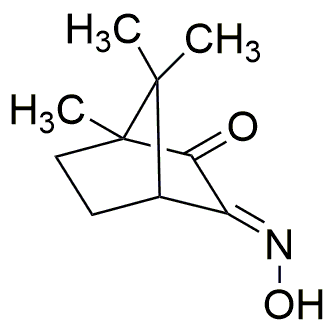anti-(1R)-(+)-Camphorquinone 3-oxime is widely utilized in research focused on:
- Organic Synthesis: This compound serves as a versatile intermediate in the synthesis of various organic molecules, enabling chemists to create complex structures efficiently.
- Photochemistry: It is employed in photochemical studies due to its unique light-absorbing properties, making it valuable for researchers exploring light-induced reactions.
- Pharmaceutical Development: The compound is investigated for its potential applications in drug formulation, particularly in designing new therapeutic agents with improved efficacy.
- Material Science: Its properties are harnessed in the development of advanced materials, such as polymers and coatings, which require specific chemical characteristics for enhanced performance.
- Analytical Chemistry: This chemical is used as a standard in various analytical techniques, aiding in the accurate quantification and identification of other compounds in complex mixtures.
General Information
Properties
Safety and Regulations
Applications
anti-(1R)-(+)-Camphorquinone 3-oxime is widely utilized in research focused on:
- Organic Synthesis: This compound serves as a versatile intermediate in the synthesis of various organic molecules, enabling chemists to create complex structures efficiently.
- Photochemistry: It is employed in photochemical studies due to its unique light-absorbing properties, making it valuable for researchers exploring light-induced reactions.
- Pharmaceutical Development: The compound is investigated for its potential applications in drug formulation, particularly in designing new therapeutic agents with improved efficacy.
- Material Science: Its properties are harnessed in the development of advanced materials, such as polymers and coatings, which require specific chemical characteristics for enhanced performance.
- Analytical Chemistry: This chemical is used as a standard in various analytical techniques, aiding in the accurate quantification and identification of other compounds in complex mixtures.
Documents
Safety Data Sheets (SDS)
The SDS provides comprehensive safety information on handling, storage, and disposal of the product.
Product Specification (PS)
The PS provides a comprehensive breakdown of the product’s properties, including chemical composition, physical state, purity, and storage requirements. It also details acceptable quality ranges and the product's intended applications.
Certificates of Analysis (COA)
Search for Certificates of Analysis (COA) by entering the products Lot Number. Lot and Batch Numbers can be found on a product’s label following the words ‘Lot’ or ‘Batch’.
*Catalog Number
*Lot Number
Certificates Of Origin (COO)
This COO confirms the country where the product was manufactured, and also details the materials and components used in it and whether it is derived from natural, synthetic, or other specific sources. This certificate may be required for customs, trade, and regulatory compliance.
*Catalog Number
*Lot Number
Safety Data Sheets (SDS)
The SDS provides comprehensive safety information on handling, storage, and disposal of the product.
DownloadProduct Specification (PS)
The PS provides a comprehensive breakdown of the product’s properties, including chemical composition, physical state, purity, and storage requirements. It also details acceptable quality ranges and the product's intended applications.
DownloadCertificates of Analysis (COA)
Search for Certificates of Analysis (COA) by entering the products Lot Number. Lot and Batch Numbers can be found on a product’s label following the words ‘Lot’ or ‘Batch’.
*Catalog Number
*Lot Number
Certificates Of Origin (COO)
This COO confirms the country where the product was manufactured, and also details the materials and components used in it and whether it is derived from natural, synthetic, or other specific sources. This certificate may be required for customs, trade, and regulatory compliance.


